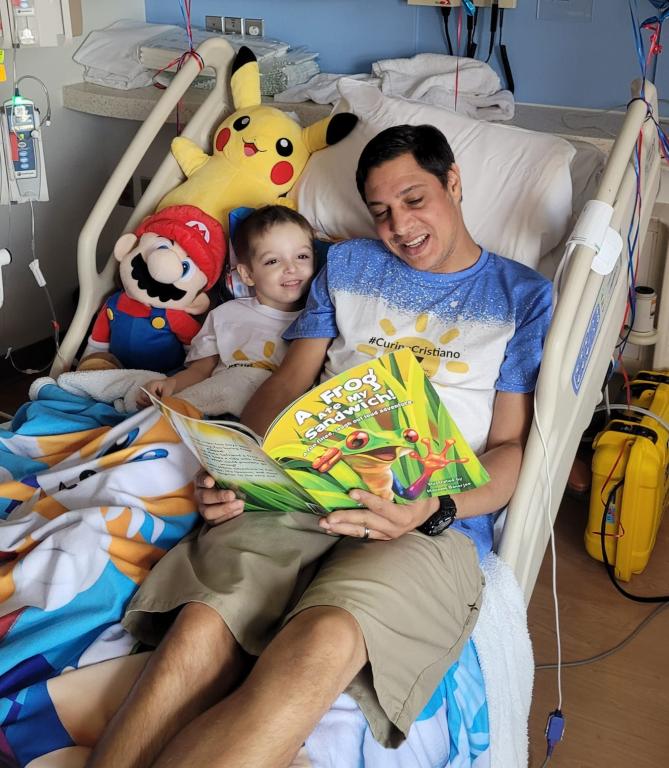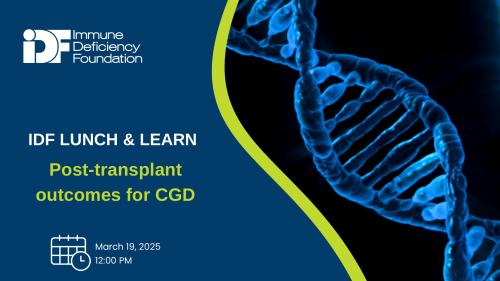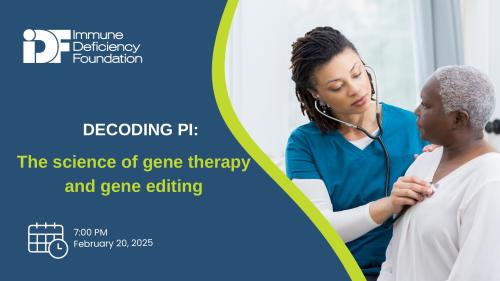
-
Understanding primary immunodeficiency (PI)

Understanding PI
The more you understand about primary immunodeficiency (PI), the better you can live with the disease or support others in your life with PI. Learn more about PI, including the various diagnoses and treatment options.
-
Living with PI
-
Addressing mental health
-
Explaining your diagnosis
- General care
- Get support
- For parents and guardians
-
Managing workplace issues
- Navigating insurance
-
Traveling safely

Living with PI
Living with primary immunodeficiency (PI) can be challenging, but you’re not alone—many people with PI lead full and active lives. With the right support and resources, you can, too.
-
Addressing mental health
-
Get involved

Get involved
Be a hero for those with PI. Change lives by promoting primary immunodeficiency (PI) awareness and taking action in your community through advocacy, donating, volunteering, or fundraising.
-
Advancing research and clinical care
-
Grants
-
IDF surveys
-
Participating in clinical trials
-
Diagnosing PI
-
Consulting immunologist
-
Clinician education

Advancing research and clinical care
Whether you’re a clinician, researcher, or an individual with primary immunodeficiency (PI), IDF has resources to help you advance the field. Get details on surveys, grants, and clinical trials.
-
Grants

Tiffany Hazlewood is a teacher who specializes in math and English as a Second Language (ESOL). When doctors diagnosed her son Cristiano Frigoli with chronic granulomatous disease (CGD) at age 2, she had to become a student again.
She learned all she could about this rare primary immunodeficiency (PI) and its curative treatment, a bone marrow transplant (BMT). She read research papers, studied statistics, scanned stories about patient experiences, and weighed the pros and cons of BMT.
“I knew a bone marrow transplant has its own inherent risk, but if I didn’t do it, while he was doing OK at the time, he’d have to stay on the medicines, which have their own long-term effects,” said Hazlewood.
“Then, looking at people who are living with CGD and talking to doctors, I just didn’t think he’d have the best quality of life, and I didn’t think he’d have the longest life.”
Based on her research and knowing that doctors found a donor match for Cristiano, Hazlewood and her husband Giancarlo Frigoli met with transplant doctors at a major children’s hospital near their home to discuss BMT. The meeting didn’t work out.

“I don't know how else to explain it other than it just didn't feel right. I felt just OK about it. The doctors made me feel very dismissed as far as my concerns,” said Hazlewood. “If you don’t make me feel like my child is going to be your priority and that my feelings aren’t important, and you want to rush it, then no.”
Determined to find another option, Hazlewood mined the internet and found a top-rated hospital about four hours away from her home, close enough that her husband and their daughter Gabby could visit. This time, when Hazlewood and her husband had their appointment with the transplant doctors, they felt confident they had chosen the right place for Cristiano.
This dogged pursuit of understanding CGD, determining the best treatment, and evaluating specialists is essential to supporting a child with CGD, said Hazlewood.
“Gather as much information and knowledge as you possibly can. Ask every question. There’s no such thing as a bad question,” said Hazlewood. “Advocate for your child. You know them better than anyone else. And the more you know, the better prepared you are to make decisions.”
Cristiano received his transplant on July 20, 2022, and recovered well with no significant complications. Doctors discharged him in mid-August, and he lived with his mom in temporary housing near the hospital for follow-up until October 30, 2022, when he went home.

“He did better than I think anybody else probably ever could, better than I ever could. The thing that amazes me about him, and about all the children we met in the bone marrow transplant unit, is that you see what they are going through every day, but they still find something to be happy about,” said Hazlewood.
Cristiano’s journey with CGD symptoms started as a toddler when he took months to recover from hand, foot, and mouth disease and other viruses, and wounds wouldn’t heal. Then, the discovery of his pupils being different sizes prompted a referral to a retina specialist, who then sent him to a rheumatologist who diagnosed him with Juvenile Idiopathic Arthritis (JIA).
The rheumatologist prescribed immunosuppressant drugs, which caused Cristiano to develop an infection in a lymph node in his neck that swelled to the size of a golf ball. Doctors said the family could wait for it to clear up, or they could remove it. Still, there was no sense of urgency about these unusual illnesses.
“My husband and I were both frustrated because I’m his mother. I know my child is not doing well, and I know it’s my job to advocate for my kid because I can see that he is suffering,” said Hazlewood. “When you’re not looking for something rare, they just kind of go with something that they know a little bit more about.”
At the urging of Hazlewood and in consultation with the rheumatologist, Cristiano underwent further testing, including a genetic evaluation, which revealed X-linked CGD caused by a spontaneous change in the genes.
“I was relieved to finally have an answer for what was going on, but I was devastated at what the answer was. Because once I started reading about CGD and learned about it, I realized just exactly how serious it was and how bleak of a diagnosis it can be,” said Hazlewood.
A year out from his BMT, Cristiano, a curious and high-energy child, can now help his mom with her gardening, play outside, dance to his favorite music, play instruments, and enjoy games of pretend with his stuffed animals.
The 5-year-old and his family also just recently took a trip to New York City (NYC) courtesy of Be the Match, the national bone marrow donor registry, to meet his stem cell donor, Ryan McLean, a NYC firefighter, and his wife Heidi, parents to children about Cristiano’s age. Hazlewood said they are like a second family now, and they’re making plans to vacation together during the summer.
“They are the most amazing people. It was just the best,” said Hazlewood, who encourages everyone to join the bone marrow registry to be donors for those who need BMT.
"It's a simple cheek swab, and you offer some basic information to join. You could save a life and give a bright future to someone, just like my son. Without Be The Match and Cristiano's donor, Ryan, he would not be the happy, healthy little boy he is today.”
In some ways, the journey with CGD has been a blessing, as Cristiano has overcome seemingly insurmountable hurdles and met talented, loving, and supportive people along the way, said his mom.
“Cristiano’s done so well, and it’s just meant to be. There’s a reason for everything,” she said.
Related resources
Sign up for updates from IDF
Receive news and helpful resources to your cell phone or inbox. You can change or cancel your subscription at any time.





The Immune Deficiency Foundation improves the diagnosis, treatment, and quality of life for every person affected by primary immunodeficiency.
We foster a community that is connected, engaged, and empowered through advocacy, education, and research.
Combined Charity Campaign | CFC# 66309



